1910 Steamship Travel Guide
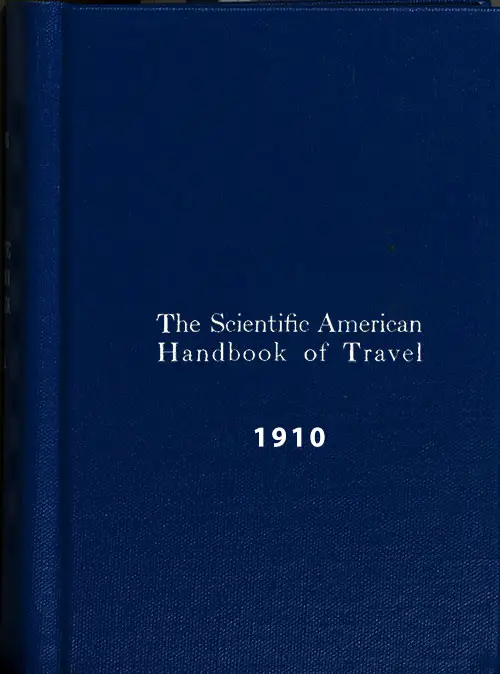
Front Cover of the 1910 Edition of The Scientific American Handbook of Travel. GGA Image ID # 17b84e188d
Superb Travel Guide from 1910 Offers general hints on how to adjust oneself to surroundings can prove so useful as on a sea voyage. This book prepares the traveler by informing him how to go, how much it will cost, how to amuse himself, and what to do on arrival at the coveted shore.
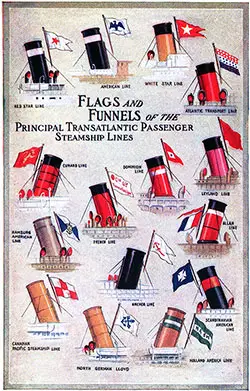
Preface to the 1910 Travel Guide
We hope that this little book will make some of the trip more interesting and that the information concerning Europe will prove of value, particularly regarding economic travel. Hundreds of pamphlets were used to produce this slender volume.
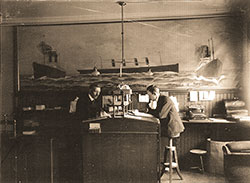
Booking Passage On A Steamship
Those who wish to rest at sea should bear this in mind. The traveler who desires comfortable lounges, palm-gardens, Dutch cafés, gymnasiums, and Turkish baths, electric baths, etc., should be willing to pay some $25.00 or more extra for each passage.
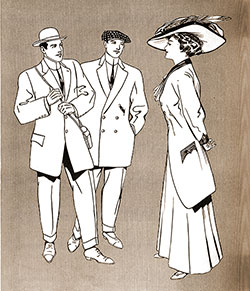
What To Pack For Your Ocean Voyage
Warm clothing and rugs should be taken for the ocean trip, as well as for the railway journeys in most European countries; even in winter the trains are seldom well heated, the primitive hot water can being very much in vogue.
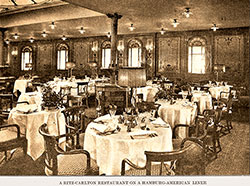
The cost of a European trip depends entirely on the time consumed, the route, and the type of accommodations required by the traveler. In planning a European trip the expense can be arrived at very closely by adding together the cost of ocean passage, both eastward and westward.
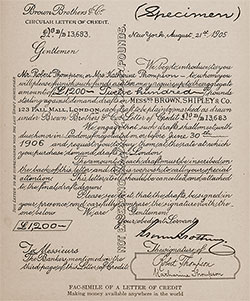
Funds Needed On Board For Voyage
The question of the fees which are to be given on ocean steamers is a most important one, not entirely from the amount of the largesse involved, but owing to the, possible annoyance which may be caused by a misunderstanding of the unwritten rules of the sea.
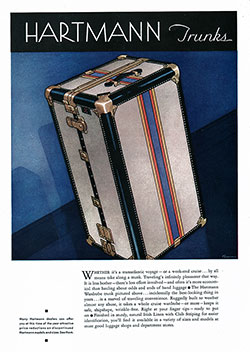
Steamer Trunks For Transatlantic Travel
The steamer trunk is the only trunk that is allowed in the stateroom. All other trunks, boxes, etc., must go in the hold of the ship. Steamer trunks should not exceed 13 inches in height, 24 inches in width, and 48 inches in length, as they can only be kept in the state-room by being placed beneath the berths and settees.
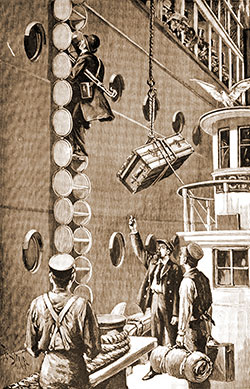
Baggage Regulations, Insurance and Storage
Each steamship company has rules relating to baggage, which should be carefully observed. The amount carried free is usually eighteen cubic feet, but this amount varies. Eighteen cubic feet mean about 200 pounds.
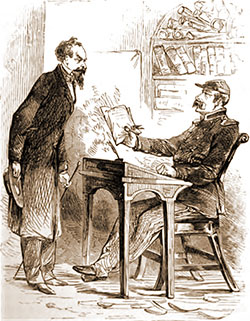
Passports are required only in Russia and Turkey. Passports are also required for entrance into the Balkan states. Visas for these countries may be obtained from their diplomatic and consular representatives in foreign countries.
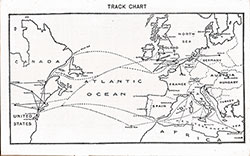
A "Grand Tour" of Europe - 1910
The following is a delightful tour, and the merits of the sights can be vouched for by the writer as he has made it. Start from London, making stops at Rochester and Canterbury; at Dover, take a steamer to Ostend.
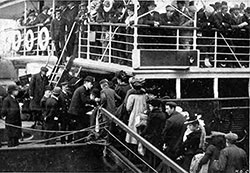
Season and Climate For Transatlantic Travel
Some parts of Europe are available for tourist purposes at all times of the year. Switzerland has its winter sports in winter, while in summer it is the great playground of Europe. The summer is preferred by many travelers, as then England, Ireland, and Scotland are at their best, and France, Belgium, Holland, and Germany are also most attractive.
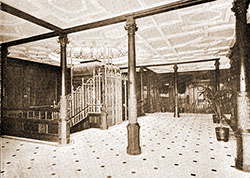
Accommodations for the first-class passengers are provided amidships extending over five decks - the main, upper, shelter, promenade and boat decks. Access from one deck to another is obtained by means of the grand and other staircases, and by two separate electric passenger lifts, which travel from the main to the boat deck.
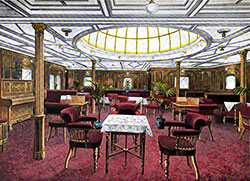
The staterooms differ from those in the first-class accommodations mainly in that they have berths instead of bedsteads, but the fittings are up to date in every particular. Many of the rooms accommodate two passengers only.
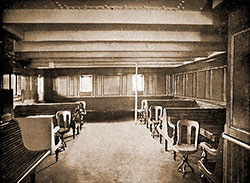
The third class is a new form of accommodation and is provided only on certain vessels of certain lines. The rate is somewhat higher than the steerage and is a good deal less than the second cabin.
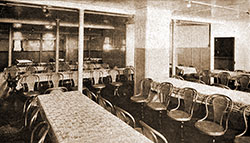
On most lines and most ships, the steerage is the third class, although on some lines, or rather on some steamers of some lines, there is a class intermediate between the second cabin and the steerage, called the third class, which may be looked upon as a kind of "improved" steerage.
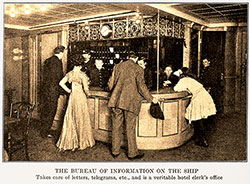
Amenities on Board an Ocean Liner
There are many amenities that passengers can take advantage of on most newer steamships, including Barber Shops, Massage, Electric Baths, Baths, Bedding, Cameras, Field Glasses, Couriers, Daily Newspaper, Darkroom Services, Divine Services, and More!
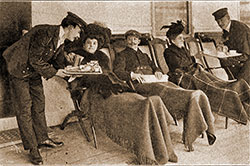
A deck chair is an important article of comfort for the voyage. It is a special chair of straw and wood, used on the deck of the ship, and each person must carry his own. These may be hired from almost any steamship company, at the price of about $1 for the voyage.
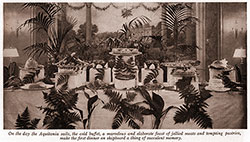
Culinary Department on a Steamship
The Culinary Department belongs to the most important departments of the modern passenger vessel and has been considerably improved and changed during the last twenty years, owing to great advancement in the art of cold storage.
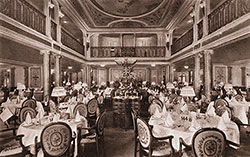
Dining Rooms and Meals on Board Ocean Liners
The grandest internal feature of these ships is, beyond all doubt, the first-class dining saloon, which is located on the saloon deck. It is a room of noble proportions and extends almost entirely across the ship.
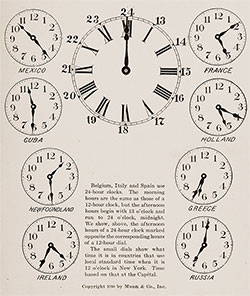
At sea, the ship's time changes daily, and the clocks, which are usually found in the companionways, are corrected. Travelers' watches should be set accordingly as the hours of meals, etc.. are dependent entirely upon these clocks.
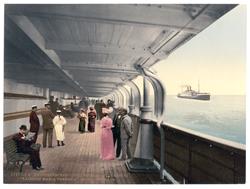
Learning to Walk on a Steamship
A long quiet roll is the simplest motion on the whole to overcome. When the ship rolls and pitches alternately, the problem is vastly complicated. It will be readily understood that any permanent upright object on the deck of a vessel will be tilted or listed to an impossible angle as the ship rolls.
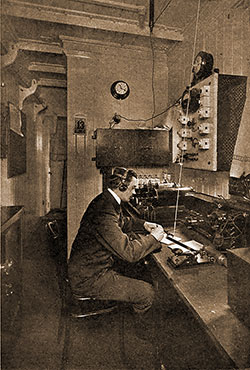
Wireless Telegraphy On Steamships
Travelers by the principal passenger vessels listed have at their disposal when at sea, a Public Telegraph Service in the Marconi Wireless Telegraph System, working in conjunction with the ordinary Inland Telegraphs and the International Cables throughout the World.
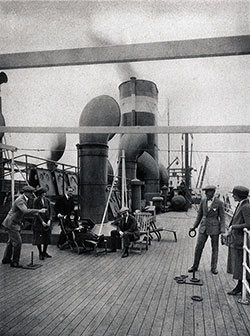
Deck quoits, shuffle-board, Bull-board, and other games are provided on the deck without any charge, under the direction of the quartermaster. Chess, dominoes, and other indoor games can be obtained on application to the library steward.
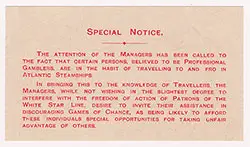
Gambling and Parimutuel Betting Pools on Ocean Liners
Among the better class of travelers who yearly cross the ocean, the question has repeatedly arisen, and very naturally too. Why Is It that gambling is so openly allowed and so openly encouraged, as it unquestionably is, by the steamship companies in the smoking-rooms of the first-class Atlantic steamers?
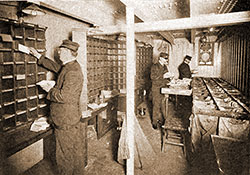
On many of the trans-Atlantic lines having mail contracts, a "marine post office" is in operation. There are sea post offices on nearly all of the express steamers belonging to lines having mail contracts.
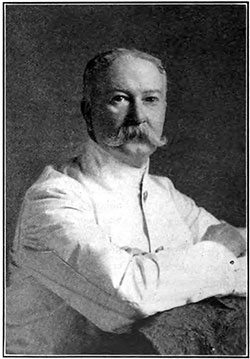
Medical Staff on Board Ocean Liners
The doctor is responsible for the health of every person on board the ship, and also for every steerage passenger, who must undergo the doctor's scrutiny so as to guard against infectious diseases being introduced into the vessel.
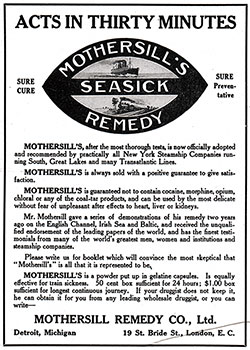
Seasickness on Steamships and Remedies
The subject of seasickness is an all-important one to eighty percent of the ocean travelers. It must be said that the boats of large tonnage have minimized this distressing ailment to a remarkable degree; the bilge keels have also tended very materially to reduce this discomfort.
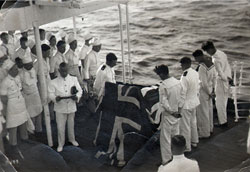
It is a mistaken notion to believe that first or second-class passenger who dies at sea are consigned to the deep. In fact, every first-class steamer carries caskets, and the surgeon will embalm the body.
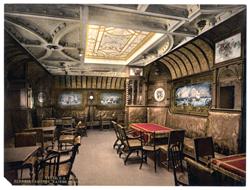
The smoking-room is an excellent, cosmopolitan club throughout the Atlantic crossing, the most democratic imaginable, with the least possible formality. The delightful, care-free life aboard the ship throughout the voyage is focused here.
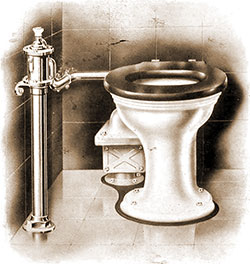
Baths and Toilet Accommodations On Steamships
An ample supply of baths for both men and women are provided on the modern liner. The men's baths are in charge of special bath stewards, who will prepare a bath at the same hour each morning.
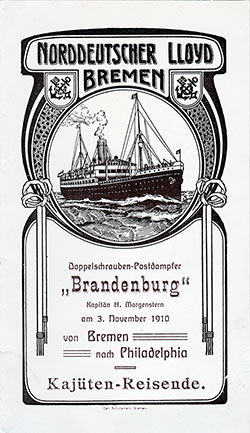
What to Expect on Your Transatlantic Voyage
This section covers the day before sailing, time of sailing, the role of stewards, passenger lists, getting underway, and what you're likely to see during your transatlantic voyage.
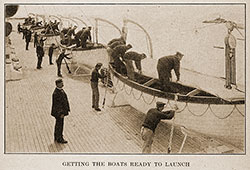
The lifeboats are maintained in perfect condition and can be launched in an incredibly small space of time, particularly where the quadrant davits are used. It is a mistake to suppose that the boats are not to be used because they are covered with canvas.
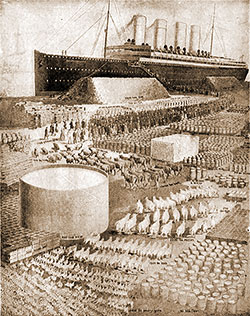
Miscellaneous Facts About Transatlantic Travel
Those who wish to see the difference between the modern liner of today with its great luxury, and the vessel of sixty years ago, should read, while onboard, Charles Dickens' account of his early voyages to America which are given in "American Notes" and "Martin Chuzzlewit."
